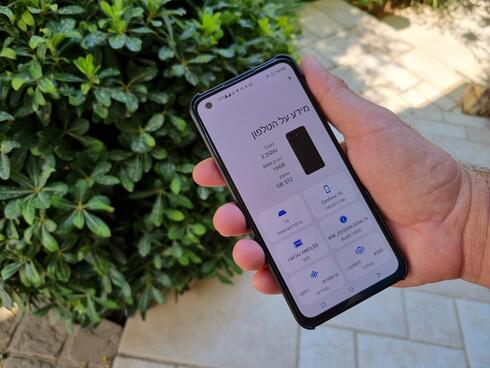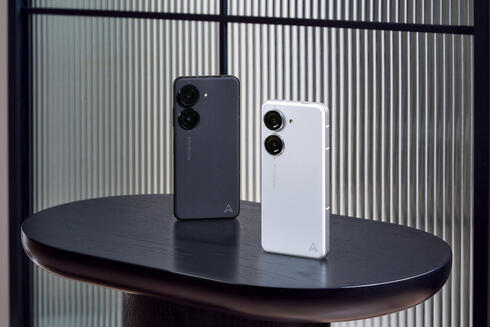
Smartphone review
Asus Zenfone 10: Balancing power and portability in a compact device
“It's logical for Asus to carve out a niche for itself and differentiate its offerings. While competitors are increasing screen sizes, Asus is instead focusing on creating a powerful device with a smaller screen, without making any compromises,” writes Itai Smuskowitz, CTech's smartphone critic
Top Line
Asus finds itself in a predicament: its smartphone sales struggle due to a lack of brand popularity in the field. Conversely, the brand's lack of popularity stems from its poor sales. Given these circumstances, it's logical for Asus to carve out a niche for itself and differentiate its offerings. While competitors are increasing screen sizes, Asus is instead focusing on creating a powerful device with a smaller screen, without making any compromises.
This approach may suffice for those who prefer a smaller screen, especially considering the limited options available in this size range, especially with powerful specifications. However, to be a compelling alternative, Asus needs to offer an affordable price. Here's where the challenge lies: the base model of the Zenfone 10, equipped with 8 GB of memory and 256 GB of storage, can cost around $1,000. Meanwhile, the model with double the memory and storage is more than $100 more expensive. With these prices, buyers could opt for larger, more popular competitors offering longer software update support. Moreover, the size difference between the Zenfone and flagship devices from Apple and Samsung is just 0.2 inches, which may not be a significant deterrent given the price disparity.
More Smartphone Reviews
Details
The trend in the field of smartphones is clear: screens are continuously growing. Whether it's a flagship device or a mid-range model, it seems that the minimum screen size threshold is 6.1 inches. Even when it comes to affordable devices, you can easily find screens of 6.6 or 6.8 inches.
Asus, a company that doesn't dominate the smartphone sales chart, believes there is still demand for smaller devices. A year after releasing the Zenfone 9, the company is now launching the Zenfone 10, a flagship device featuring a "mere" 5.9-inch screen. While many aspects of the new model remain unchanged, it is primarily distinguished by upgrades to more recent components, such as the processor and camera.
Compact Structure and Design with Presence
The new Zenfone closely resembles its predecessor, boasting a compact design that feels sturdy and slightly heavy relative to its size. Weighing in at only 172 grams, it's comparable to the S23 and iPhone 14. However, it's expected that a smaller device would be lighter. The difference between it and other smartphones starts at just 0.2 inches, but it's certainly noticeable. The Zenfone fits comfortably in the palm of your hand and pocket, which aligns with one of Asus' objectives.
The screen is entirely flat with a thin frame, the selfie camera is positioned in the upper left corner, and there's minimal extra space. Power and volume buttons are located on the right side, similar to any standard smartphone. The power button also serves as a fingerprint reader, which performs well.
Asus distinguishes itself from competitors not only in terms of screen size but also by including a standard headphone jack. Furthermore, the device adheres to the IP68 standard, making it dust-resistant and capable of surviving a 30-minute submersion in water up to a depth of 1.5 meters.
The screen is shielded by Victus Gorilla Glass, the frame is crafted from aluminum, and the back is composed of plastic. Overall, the device feels solid and robust. Additionally, the kit comes with a basic plastic protector.
The integration of numerous features into a compact body comes at a price that manifests itself in other aspects. The Zenfone 10 measures 9.4 mm in thickness, slightly more than the previous model and many other leading devices today. This discrepancy is barely noticeable and contributes to the device's sense of durability. The two lenses on the back of the device protrude slightly from the body, with the upper one standing out a bit more than its counterpart.
Powerful Hardware Comparable to Larger Competitors
Physically, the device is compact, but in terms of performance, no compromises are made. The Zenfone 10 is powered by the Snapdragon 8th generation 2 processor. The model tested has 16 gigabytes of memory and 512 gigabytes of storage (without an expansion card slot). As a result, the device handles every task with ease—whether it's running intensive games, playing music, browsing the internet, capturing photos, or watching videos. Even after extended gaming sessions with rich graphics, the device only slightly warms up, without impacting its usability.
The screen offers excellent quality, displaying sharp visuals and vibrant colors. With a brightness of up to 1,100 nits, content remains easily readable even in bright sunlight. Although the automatic brightness adjustment isn't always accurate, it does the job gradually, resembling a fade effect.
The screen dimensions become apparent when browsing social networks and reading texts. The default font size is somewhat small. While this can be adjusted in the settings menu, it would be better for Asus to modify the default setting.
The speakers surprised me significantly—the sound quality is high and loud for a smartphone. Bass tones are well-defined, stereo sound distribution is clear, and the manual equalizer can be adjusted according to personal preference. Listening modes such as music, game, movie, or dynamic can also be selected. These modes adapt the audio settings based on the current activity.
Backing these features is a 4,300 mAh battery that easily lasts an entire day, even with gaming, video recording, web browsing, and other regular use activities. The Zenfone supports wireless charging at 15 watts, and the kit includes a 30-watt charger. Although not the fastest, it efficiently charges the device. A 25-minute charge was sufficient to reach 50% battery capacity, while a full charge required over an hour.
Software and Interface: Nearly Clean and User-Friendly Android
The Zenfone runs on Android 13 with Asus Zen interface. The experience is quite close to "clean" Android with some additions. Asus avoids overloading the device with unnecessary apps, instead installing basic utilities. These include a calculator, gallery, content transfer app, weather, voice recorder, and more.
Unlike the Pixel 7a, which offers clean Android, the Zenfone provides pop-up messages suggesting the use of additional features, options, and shortcuts. Navigation can be performed using finger gestures or display navigation buttons at the bottom of the screen, each of which can be customized. For instance, the power button can be double-clicked to instantly open the camera and capture an image, or to activate the Google Assistant. Customization options abound, including assigning actions to sliding your finger on the power key or volume keys.
One notable flaw lies in the phone’s update support. The company officially commits to two "major" Android updates and four years of security updates. While it's true that devices don't remain in use for long periods, competitors offer support for a longer duration. Considering the launch of Android 14, which will use one of the promised updates, Asus falls short.
Camera: Impressive Results without Excessive Effects
The device's rear hosts two cameras: a main 50-megapixel sensor with a gimbal mechanism for image stabilization, and a 13-megapixel sensor for wide-angle shots. The selfie camera features a 32-megapixel sensor.
While special effects to enhance colors are absent, the camera delivers successful results. Photos preserve natural colors without excessive enhancement. Night mode yields impressive low-light photos with instant results, demonstrating increased light and improved image quality on the screen immediately after capturing the shot.
One feature highlighted by Asus in the Zenfone is a six-axis image stabilization mechanism similar to a gimbal. This mechanism ensures the phone remains stable in various positions and situations. While taking photos, a line helps users determine if the camera is level or tilted at an angle. The true highlight, however, is in video usage. The gimbal minimizes vibrations and jerks, resulting in smooth videos even when walking or running. Two stabilization levels, Adaptive Stabilization and Super Stabilization, are available. Unfortunately, Super Stabilization is limited to Full HD quality, leaving users with the lower level when shooting in 4K or 8K.


